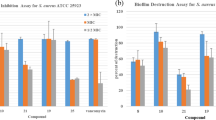Abstract
We studied the effects of quaternary bis-phosphonium and bis-ammonium salts of pyridoxine with lipophilic substituents on the survival and morphology of Staphylococcus aureus cells. We found that, while originating from the same base, they exhibit considerably different antimicrobial mechanisms. In the presence of Ca2+ ions the MIC and MBC values of ammonium salt increased 100-fold, suggesting that Ca2+ ions can successfully impede the membrane Ca2+ ions exchange required for ammonium salt incorporation. In contrast, in the presence of quaternary phosphonium salt, the artificial capsular-like material was formed around the cells and the filamentous and chain-like growth of the cells was observed suggesting the disruption of the cell division mechanisms. Altogether, both pyridoxine derivatives successfully inhibited the growth of gram-positive bacteria (Staphylococcus aureus, Staphylococcus epidermidis, Bacillus subtilis) and Escherichia coli considerably, while demonstrated nearly no effect against Klebsiella pneumoniae and Pseudomonas aeruginosa. We suggest that due to their effects on distinct and likely complementary targets the derivatives of pyridoxine represent potentially perspective antibacterials with complicated adaptation and thus with lower risk of drug resistance development.





Similar content being viewed by others
References
Aquino A, Chan J, Giolma K, Loh M (2010) The effect of a fullerene water suspension on the growth, cell viability, and membrane integrity of Escherichia coli B23. J Exp Microbiol Immunol 14:13–20
Bruinsma GM, Rustema-Abbing M, van der Mei HC, Lakkis C, Busscher HJ (2006) Resistance to a polyquaternium-1 lens care solution and isoelectric points of Pseudomonas aeruginosa strains. J Antimicrob Chemother 57:764–766
Chang H-I, Yang M-S, Liang M (2010) The synthesis, characterization and antibacterial activity of quaternized poly(2,6-dimethyl-1,4-phenylene oxide)s modified with ammonium and phosphonium salts. React Funct Polym 70:944–950
Cherkasov RA, Bakhtiarova YV, Andriyashin VV, Galkina IV, Galkin VI (2013) Synthesis and antibacterial activities of phosphonium salts on basis of triphenylphosphine and 3,5-di-tert-butyl-4-hydroxybenzyl bromide. Phosphorus Sulfur Silicon Relat Elem 188(1):97–101
Conrad RS, Howard MJ, Garrison RC, Winters S, Henderson DA (1998) The effects of daptomycin on chemical composition and morphology of Staphylococcus aureus. Proc Okla Acad Sci 78:15–22
Crismaru M, Asri LATW, Loontjens TJA, Krom BP, de Vries J, van der Mei HC, Busscher HJ (2011) Survival of adhering staphylococci during exposure to a quaternary ammonium compound evaluated by using atomic force microscopy imaging. Antimicrob Agent Chemother 55(11):5010–5017
Das T, Sehar S, Koop L, Wong YK, Ahmed S, Siddiqui KS, Manefield M (2014) Influence of calcium in extracellular DNA mediated bacterial aggregation and biofilm formation. PLoS ONE. doi:10.1371/journal.pone.0091935
Denyer SP, Stewart GSAB (1998) Mechanisms of action of disinfectants. Int Biodet Biodegrad 41:261–268
Galkina I, Bakhtiyarova Y, Shulaeva M, Pozdeev O, Egorova S, Cherkasov R, Galkin V (2013) Synthesis and antimicrobial activity of carboxylate phosphabetaines derivatives with alkyl chains of various lengths. J Chem, ID 302937
Gilbert P, Moore LE (2005) Cationic antiseptics: diversity of action under a common epithet. J Appl Microbiol 99(4):703–715
Greenwood D, O’Grady F (1969) Antibiotic-induced surface changes in microorganisms demonstrated by scanning electron microscopy. Science 163:1076–1078
Kanazava A, Ikeda T, Endo T (1994) Synthesis and antimicrobial activity of dimethyl- and trimethil-substituted phosphonium salts with alkyl chains of various lengths. Antimicrob Agents Chemother 38(5):945–952
Kolesika B, Motylski R, Kamnski ZJ, Kwinkowski M, Kaca W (2011) Synthesis of P-triazinylphosphonium salts—hybrid molecules with potential antimicrobial activity. Acta Pol Pharm Drug Res 68(3):387–391
Listvan VN, Listvan VV, Malishevskaya AB, Deineka SE (2009) Triphenylphosphonium salts benzyl type and their antimicrobial properties. J Org Pharm Chem 6(4):77–80
Marcotte L, Barbeau J, Lafleur M (2005) Permeability and thermodynamics study of quaternary ammonium surfactants-phosphocholine vesicle system. J Colloid Interface Sci 292:219–227
Pan C, Rezaei H, Soor A (2011) Chitosan disrupts membrane permeability of lactic acid bacteria. JEMI 15:7–14
Popa A, Davidescu CM, Trif R, Ilia Gh, Iliescu S, Dehelean Gh (2003) Study of quaternary ‘onium’ salts grafted on polymers: antibacterial activity of quaternary phosphonium salts grafted on ‘gel-type’ styene-divinylbenzene copolymers. React Funct Polym 55:151–158
Pugachev MV, Shtyrlin NV, Sapozhnikov SV, Sysoeva LP, Iksanova AA, Nikitina EV, Musin RZ, Lodochnikova OA, Berdnikov EA, Shtyrlin YG (2013a) Bis-phosphonium salts of pyridoxine: the relationship between structure and antibacterial activity. Bioorg Med Chem 21(23):7329–7341
Pugachev MV, Shtyrlin NV, Sysoeva LP, Nikitina EV, Abdullin TI, Iksanova AA, Ilaeva AA, Musin RZ, Berdnikov EA, Shtyrlin YG (2013b) Synthesis and antibacterial activity of novel phosphonium salts on the basis of pyridoxine. Bioorg Med Chem 21(14):4388–4395
Shtyrlin NV, Sapozhnikov SV, Koshkin SA, Iksanova AG, Sabirov AH, Kayumov AR, Nureeva AA, Zeldi MI, Shtyrlin YG (2015) Synthesis and antibacterial activity of novel quaternary ammonium pyridoxine derivatives. Med Chem 11(7):656–665
Tingting W, Xiaoqun W, Guiyong, Shanyi D (2012) Synthesis and antibacterial pperformance of quaternary phosphonium salts with reactive hydroxyl group. China Petroleum Processing and Petrochemical Technology 14(2):76–81
Togashi N, Shiraishi A, Nishizaka M, Matsuoka K, Endo K, Hamashima H (2007) Antibacterial activity of long-chain fatty alcohols against Staphylococcus aureus. Molecules 12:139–148
Wale LJ, Shelton AP, Greenwood D (1989) Scanning electron microscopy of Staphylococcus aureus and Enterococcus faecalis exposed to daptomycin. J Med Microbiol 30:45–49
Acknowledgments
This work was funded by the subsidy allocated to Kazan Federal University by Federal Targeted Program for Research and Development in Priority Areas of Development of the Russian Scientific and Technological Complex for 2014–2020 (Project No. 14.575.21.0037 from 27.06.2014, the unique identifier of the agreement RFMEF157514X0037).
Author information
Authors and Affiliations
Corresponding author
Rights and permissions
About this article
Cite this article
Nikitina, E.V., Zeldi, M.I., Pugachev, M.V. et al. Antibacterial effects of quaternary bis-phosphonium and ammonium salts of pyridoxine on Staphylococcus aureus cells: A single base hitting two distinct targets?. World J Microbiol Biotechnol 32, 5 (2016). https://doi.org/10.1007/s11274-015-1969-0
Received:
Accepted:
Published:
DOI: https://doi.org/10.1007/s11274-015-1969-0




